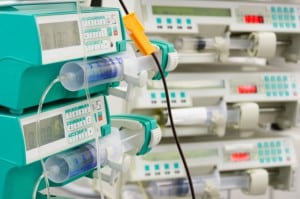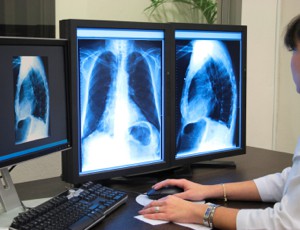Hazard analysis of class I recalls related to infusion pumps

This study aimed to establish a hazard classification framework of medical devices and to apply it over practical adverse event data on infusion pumps” Gao et al (2019). Abstract: BACKGROUND: The adverse event report of medical devices is one of the postmarket surveillance tools used by regulators to monitor device performance, detect potential device-related safety […]
Prothrombin complex concentrate administration via intraosseous access

In patients lacking IV access, effective PCC administration becomes problematic. No previous case reports have documented PCC infusion via intraosseous (IO) or alternative routes in this setting” Peyko et al 92019). Abstract: BACKGROUND: Vitamin K antagonist (VKA) reversal in patients with acute major bleeding and coagulopathy is an example of an urgent intervention in the […]
Embolized guidewire into central aorta following central venous catheterization

During an attempt to insert a central line into the right subclavian vein at bedside, the guidewire inadvertently entered the subclavian artery and embolized distally” Nath et al (2019). Abstract: A 4-month-old preterm, critically ill infant weighing 3.8 kg was admitted to our pediatric intensive care unit with congestive cardiac failure due to a large ventricular […]
Patient with bilateral ectopic subclavian vein catheterization

This case suggests that clinical physician should be careful to prevent catheter heterotopia in subclavian vein catheterization, and postoperative routine chest X-ray examination is necessary to identify position of the catheter” Huang et al (2019). Abstract: One female patient aged 18 years, with severe burns and inhalation injury was admitted to our unit on June […]
Staphylococcus aureus colonization in hemodialysis patients

We prospectively followed a cohort of 86 hemodialysis patients from an outpatient dialysis center over 25 months analyzing S. aureus carrier status, S. aureus infection rates and mortality” Scheuch et al (2019). Abstract: BACKGROUND: Dialysis patients are frequently exposed to Staphylococcus aureus due to stays in dialysis centers, hospitals or rest homes. The hemodialysis vascular access […]
Efficacy and safety of a virtual reality distraction for needle pain in children

To assess the efficacy and safety of a virtual reality distraction for needle pain in 2 common hospital settings” Chan et al (2019). Abstract: OBJECTIVE: To assess the efficacy and safety of a virtual reality distraction for needle pain in 2 common hospital settings: the emergency department (ED) and outpatient pathology (ie, outpatient laboratory). The […]
Short central venous catheter tip results in extravasation

We undertook a quality improvement project involving a standardised bundle of care and a peri-operative central venous catheter insertion checklist with the aim of reducing the risk of such an incident re-occurring.” Hade et al (2019). Abstract: Central venous catheter insertion is a routine procedure performed by anaesthetists in the peri-operative setting. Upper body central […]
Distal end of the CVC damaged due to radiofrequency energy

We present a patient who underwent mitral valve replacement (MVR) and a concomitant CM-IV procedure in which the distal end of the CVC was damaged due to RF energy” de Rooij et al (2019). Extract: “About 12% of patients undergoing cardiac surgery and 30% of patients undergoing mitral valve surgery experience atrial fibrillation (AF).1 The […]
Study of pain response in neonates during venipuncture

This study found that topical anesthetic agents were effective in reducing pain during venipuncture” Kaur et al (2019). Abstract: BACKGROUND: Neonates being nonverbal are unable to express their pain leading to underestimation of their pain and hence insufficient pain relief. Neonatal pain is assessed by pain scales based on the behavioural and physiological changes that […]
Pharmacoeconomic evaluation of antibiotic treatment for complicated skin infection

We performed a network meta-analysis (NMA) to compare the efficacy and safety of antibiotics used to treat inpatients with complicated skin and soft structure infections” Zhang et al (2019). Abstract: Background: Infections due to methicillin-resistant Staphylococcus aureus (MRSA) cause serious health risks and significant economic burdens and the preferred drugs are still controversial. Methods: We […]
Candida catheter-related bloodstream infection in patients on home PN

This review clarifies Candida CRBSI rates by species, risk factors, outcomes, and management to improve effectiveness of HPN programs” Phua et al (2019). Abstract: BACKGROUND: Catheter-related bloodstream infections (CRBSIs) are life-threatening complications for home parenteral nutrition (HPN) patients. This review clarifies Candida CRBSI rates by species, risk factors, outcomes, and management to improve effectiveness of […]
Hydrochloric acid prolongs the lifetime of central venous catheters in patients with bacteraemia

This study investigated if the additional use of hydrochloric acid (HCl) as an intraluminal lock solution may prolong the lifetime of the CVC” Ahmad et al (2019). Abstract: INTRODUCTION: Bacteraemia in adult patients undergoing treatment for leukaemia is common and associated with profound morbidity and mortality. Infections related to the use of a central venous […]
Impact of prophylactic use of taurolidine-citrate lock on CLABSI in children

The aim of the study was to evaluate prophylactic use of taurolidine-citrate (T-C) solution on the number of CRIs” Małgorzata et al (2019). Abstract: Central venous access poses a risk of developing CRIs. The aim of the study was to evaluate prophylactic use of taurolidine-citrate (T-C) solution on the number of CRIs. 97 catheters, used […]
Presence of invasive devices and risk of healthcare-associated infections

The present study evaluated the daily risk of healthcare-associated infections and sepsis (HAIS) events in pediatric intensive care unit patients with invasive devices” Bennett et al (2018). Abstract: The present study evaluated the daily risk of healthcare-associated infections and sepsis (HAIS) events in pediatric intensive care unit patients with invasive devices. This was a retrospective […]
Review of paediatricians who diagnose and manage cellulitis

There is a lack of evidence-based guidance for management of cellulitis and use of outpatient parenteral antimicrobial therapy (OPAT) in children” Ibrahim et al (2019). Abstract: There is a lack of evidence-based guidance for management of cellulitis and use of outpatient parenteral antimicrobial therapy (OPAT) in children. The only published guidelines for skin infections are […]
Investigation of complications following implantable port insertion in cancer patients

This retrospective single-institutional review was performed to identify rates of complications from port placement and potential factors associated with these events” Skelton et al (2019). Abstract: Central venous access devices, specifically implantable ports, play an essential role in the care of oncology patients; however, complications are prevalent. This retrospective single-institutional review was performed to identify […]
Clinical characteristics and outcomes of patients receiving OPAT

In our study, OPAT is found to be efficacious in saving hospitalization’s days, with a low rate of readmissions and complications and a high patients’ level of satisfaction. We therefore conclude that OPAT is feasible and safe” Briquet et al (2019). Abstract: BACKGROUND: Outpatient parenteral antibiotic therapy (OPAT) was not used in Belgium before 2013, […]
Analysis of clinical blood use in emergency blood loss patients

To explore the blood transfusion data of emergency hemorrhage patients, so as to provide the basis for improving the quality of emergency blood transfusion and guiding clinic rational blood transfusion” Jiang et al (2019). Abstract: OBJECTIVE: To explore the blood transfusion data of emergency hemorrhage patients, so as to provide the basis for improving the […]
Antibiotic-impregnated central venous catheters in the neonatal intensive care unit

It is often unclear what proportion of an improvement is attributable to each element of these care bundles and, as such, a single intervention such as antibiotic impregnation of CVCs might have too small an effect to be demonstrable” Khatami and Isaacs (2019). Extract: As Gilbert and colleagues point out,5 other infection prevention strategies in […]
Antimicrobial-impregnated central venous catheters for prevention of neonatal bloodstream infection

We found no evidence of benefit or harm associated with miconazole and rifampicin-impregnated PICCs compared with standard PICCs for newborn babies” Gilbert et al (2019). Abstract: BACKGROUND: Bloodstream infection is associated with high mortality and serious morbidity in preterm babies. Evidence from clinical trials shows that antimicrobial-impregnated central venous catheters (CVCs) reduce catheter-related bloodstream infection […]
Predicting failure of intravenous access in adults

Our aim was to validate prior need for an advanced technique to establish intravenous access as a predictor of failure to achieve access via traditional methods and to estimate the risk difference associated with this finding” Witting et al (2019). Abstract: BACKGROUND: When intravenous access cannot be established using traditional methods of inspection/palpation, advanced methods […]
IV flush volume required for peripheral intravenous catheters

“To test the feasibility of an efficacy trial comparing different flushing frequencies and volumes to reduce peripheral intravenous cannula (PIVC) failure in paediatric inpatients” Kleidon et al (2019).
CLABSI in pediatric hematology-oncology inpatients

This cross-sectional study was a retrospective review of CLABSI in inpatient pediatric hematology-oncology cases with long-term central venous catheter at the Pediatric Hematology Department from January 2013 to June 2014″ Özalp Gerçeker et al (2019). Abstract: Central line-associated bloodstream infections (CLABSIs) are still a major cause of morbidity and mortality in pediatric hematology-oncology patients in […]
Development of a unit-based safety program to prevent CLABSI

Interventions included the Comprehensive Unit-based Safety Program to improve safety culture and evidence-based bundles to prevent central line-associated bloodstream infection (CLABSI), surgical site infection (SSI), and ventilator-associated pneumonia (VAP)” Chang et al (2019). Abstract: Using a pre-post design, this study examined the impact of a multifaceted program to simultaneously improve 3 health care-associated infections and […]
Systematic review examines risk of bloodstream infection associated with implantable ports

This systematic review and meta-analysis aimed to provide evidence-based guidance to better understand the risk of central line-associated bloodstream infection (CLABSI) in cancer patients who received totally implantable venous access ports (TIVAPs) compared with those who received external central venous catheters (CVCs)” Jiang et al (2019). Abstract: OBJECTIVE: This systematic review and meta-analysis aimed to […]
Infection free midline catheter implementation reviewed

Adoption of a vascular access nurse led midline catheter program, coupled with device selection algorithms expanded the ability to select the right device for the patient, while decreasing excess central line usage without additional increased risks to the patient” DeVries et al (2019). Abstract: BACKGROUND: To reduce excess central line use and provide an option […]
Infection risk of small-bore tunneled central venous catheters

The purpose of this study is to evaluate the association of common clinical variables with small-bore tunneled central venous catheter (CVC) infection” Black et al 92019). Abstract: OBJECTIVE: The purpose of this study is to evaluate the association of common clinical variables with small-bore tunneled central venous catheter (CVC) infection. MATERIALS AND METHODS: Retrospective data […]
Effectiveness of synthetic polymer-coated peripherally inserted central catheter

Patients with advanced cancers who had indwelling PICCs were reviewed using their medical records. Three types of PICCs were compared in terms of complications and catheter failure” Takezawa et al (2019). Abstract: BACKGROUND/AIM: A peripherally inserted central catheter (PICC) is recommended for the safe administration of anticancer agents. The effectiveness of synthetic polymer-coated and non-coated […]
Article describes controlled infusion of intravenous cardiac drugs

The objective of the study is to develop an automatic drug infusion control system during cardiovascular surgery” Sowparnika et al (2019). Abstract: OBJECTIVES: The objective of the study is to develop an automatic drug infusion control system during cardiovascular surgery. MATERIALS AND METHODS: Based on the clinical drug dosage analysis, the modeling of cardiovascular system […]
Scoping review examines practices related with tourniquet use during peripheral venipuncture

This scoping review aims to map the available evidence on health professionals’ practices related with tourniquet use during peripheral venipuncture and associated microbiological contamination” Salgueiro-Oliveira et al (2019). Abstract: OBJECTIVES: During peripheral venipuncture, health professionals are recommended to use a tourniquet above the puncture site in order to potentiate venous distension. Given its characteristics and […]

